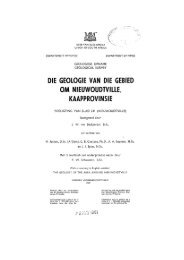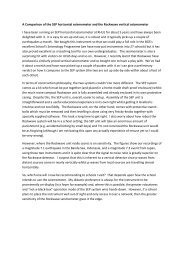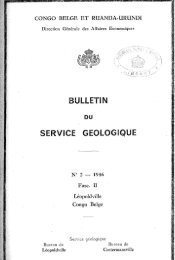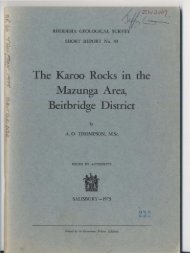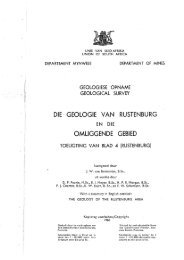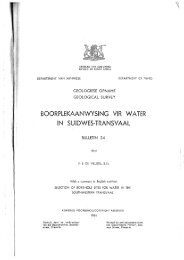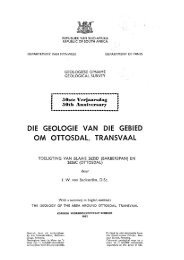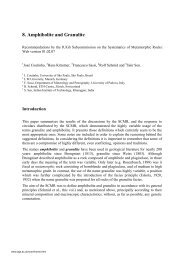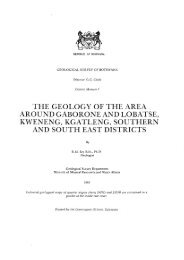Bibliography - British Geological Survey
Bibliography - British Geological Survey
Bibliography - British Geological Survey
You also want an ePaper? Increase the reach of your titles
YUMPU automatically turns print PDFs into web optimized ePapers that Google loves.
Keith, A. 1950. An autobiography. London: Watts & Co, 721 pp. (Recollections of Piltdown, pp. 323‒329,<br />
644‒645, 654. Keith admits to ‘a feeling of jealousy’ that the Piltdown skull had gone to Smith Woodward<br />
at the Natural History Museum, rather than to his own Museum at the Royal College of Surgeons. He notes<br />
that ‘As a palaeontologist Smith Woodward enjoyed, and deserved, the highest reputation, but he had no<br />
special knowledge of the human body. In our chance meetings he had struck me as a proud and cold man,<br />
one with whom I found it difficult to establish a friendship. No doubt he was just as jealous for the interests<br />
of his institution as I was for mine.’ Keith describes his first impression of the skull and jaw, along with<br />
Woodward’s reconstruction, which he was invited to examine at South Kensington on 2 Dec 1912, his<br />
observations being carefully noted in his diary later that evening. His outspoken criticism of Woodward’s<br />
reconstruction of the skull led to a meeting at the Museum of the Royal College of Surgeons in July 1913,<br />
which was attended by Woodward, Lankester, Pycraft, Underwood, Smith and Keith. In that year he<br />
resolved to write a book on Piltdown man, which soon expanded into a systematic account of all the<br />
important discoveries that had been made of prehistoric man (Keith 1915). In later years he and Smith<br />
Woodward became good friends and joint defenders of Piltdown man. Keith spent several months to June<br />
1938 attempting a new reconstruction of the Piltdown skull, which was resolved to his satisfaction only<br />
when he determined that the left and right side of the skull were asymmetrical, the left half being much<br />
larger than the right. He spent eleven months exploring all aspects of the Piltdown–Swanscombe problem,<br />
the results of which were published in 1939. He mentions on more than one occasion the great warmth and<br />
respect that both he and Smith Woodward felt toward the ‘honest’ Charles Dawson.)<br />
Keith, A. (see also: Anon. 1938, 1955; Dawson & Woodward 1912, 1913b; Harris, W. E. ; Woodward<br />
1917b, 1948; for obituary see Le Gros Clark 1955c)<br />
Keith, L. J. 1990. Piltdown plot. New Scientist, 128 (20 Oct), 59. (In response to Pat Shipman’s review of<br />
Frank Spencer’s recently published book in which he accuses Arthur Keith of being the Piltdown forger, the<br />
following letter was received from Lindsay Keith: ‘The notion that my late great uncle the anthropologist Sir<br />
Arthur Keith forged or even took any part in the Piltdown forgery is silly beyond belief. It does not stand up<br />
to serious examination. Of all those who stood to lose from such a fraud on the scientific establishment of<br />
the time, Keith had most to lose. It was no pleasure for him to be told at the age of 87 that modern dating<br />
methods had shown that he had been fooled over some 40 years. If he had been the forger, why would he<br />
have been still puzzling over the skull as long after the 1912 “discovery” as 1939?’)<br />
Kelly, R. 1998. For sale: the house with a missing link. The Times, 23 Sept. (The East Sussex manor where<br />
the remains of Piltdown man were found has been put up for sale for £1.6 million. The present Barkham<br />
Manor was built in the mid-1830s on the site of a much older house, and was extended in the 1920s. The<br />
current owner, Mark de Gruchy Lambert, was responsible for establishing Barkham Manor Vineyards in<br />
1985 (wine retails under the name ‘Piltdown Man’). A detached oast house, barn, and modern buildings<br />
housing the winery and the vineyard are included in the sale.)<br />
Kennard, A. S. 1947. Fifty and one years of the Geologists’ Association. Proceedings of the Geologists’<br />
Association, 58 (4), 271–293. (In briefly discussing the eolithic controversy, the writer notes that ‘My<br />
mature judgement is that some show human work or usage but their age is uncertain. Over-enthusiasm has,<br />
however, been too prevalent, and I cannot see any trace of human work in the Eoliths from Piltdown.’ There<br />
are also observations on W. J. Lewis Abbott, who ‘was a short, stocky man, with a ferocious moustache,<br />
nearly always wore a boater in the field, and came from a remote part of Essex, the Dengie Hundred... Abbott<br />
was possessed of great imagination, but little clarity of exposition, and his papers are the worse for it... If the<br />
stories I have heard are to be believed, in his later years his imagination had complete control.’)<br />
Kennard, A. S. (contribution to discussions in Dawson & Woodward 1912, and Dawson & Woodward<br />
1914b; see also under Hinton; for a biography of Kennard see Preece 1990)<br />
Kennedy, K. A. R. 1991. Book Review: [Spencer 1990]. American Journal of Human Biology, 3 (3), 308-<br />
310. (Accuses Chipper the goose)<br />
Kennedy, K. A. R. (see under Tobias; and contribution to discussion in Tobias 1992c)<br />
Kenward, M. 1955a. The plain and simple truth about the actual finding of the Piltdown skull. Daily<br />
Telegraph, 23 Feb. (A reaction to Weiner 1955b. The correspondent, Miss Mabel Kenward of Barkham<br />
Manor, says of Charles Dawson, who was steward of the manor, that ‘On one occasion he noticed my<br />
father’s workmen digging gravel by the side of the drive leading up to the house and asked if he might be<br />
allowed to watch for anything that looked different from the ordinary gravel stones (flints). One day when<br />
they were digging in unmoved gravel, one of the workmen saw what he called a coconut. He broke it with



